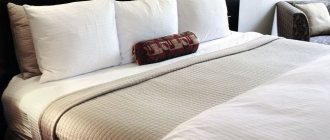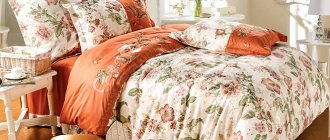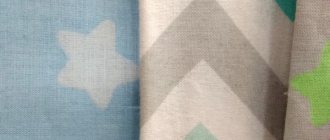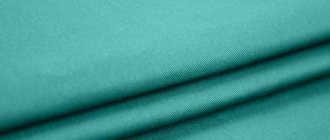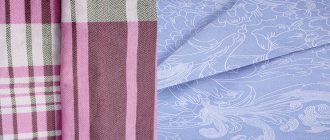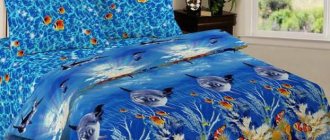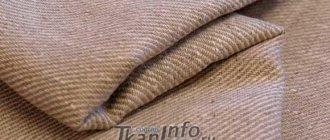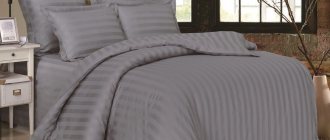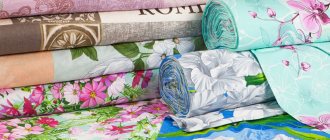Unfortunately, in pursuit of profit, manufacturers simplify technological processes, use cheaper synthetic fibers, “forgetting” to report this on the label. Therefore, on sale you can find both cheap “satin” and “poplin”, which costs less than chintz.
In fact, high-quality poplin is always more expensive than both chintz and calico. But cheaper than satin. Satin is the most expensive among cotton fabrics. The minimum price for a one-and-a-half set made of poplin cannot be less than 1,500 rubles, and one made of satin – 1,900 rubles.
Knowledge of GOST will help you avoid falling for the manufacturer’s tricks. The density of high-quality poplin is 115 g/m2. Satin density: 120–140 g/m2.
What is softer, satin or poplin?
You can describe the softness of satin endlessly, remembering how easily it flows and drapes, how softly it sinks the body into silky sheets. Poplin is based on thick threads, so in terms of softness it is noticeably inferior to its competitor.
In addition to the usual double-sided satin, you can also find other types of material on sale: satin jacquard with a convex relief pattern and stripe satin, which can be recognized by alternating matte and glossy stripes. Both materials retain all the advantages of satin, but differ from the classic variation in that they do not have a front and back side. They are both exactly the same.
What care does poplin require?
The care required for a poplin bedding set is indicated on the packaging
Poplin is easy to care for. The material is not capricious and does not require special conditions during operation. On a flat surface, the fabric straightens out on its own. Therefore, you can not iron it at all or iron it lightly. After washing, the shape of the product remains the same. No deformation occurs. Normal washing cycle is suitable.
Which is easier to care for?
Caring for poplin depends on the composition of the material. If the manufacturer has added synthetic fibers, the bed can be washed at a maximum of 40 0C. Otherwise, your favorite underwear will shrink. The inclusion of silk fibers suggests hand washing only. And if you trust the washing machine, then set it to the most gentle mode and low speed. You can iron poplin, but the iron temperature should not be at its maximum.
The easiest to care for is poplin made from natural cotton. You can even boil it, and this will not cause the fabric to shrink. Of course, such experiments are only permissible with bleached materials. Drawing requires a more careful attitude.
Pillowcases and duvet covers should be washed inside out. This way you can tidy up the corners of your items, where dust from blankets and pillows always accumulates.
Satin is often called “eternal bed linen.” And this statement is not far from the truth. Satin sets can withstand up to 300 washes and at the same time do not lose either the brightness of their colors or their softness. Linen should be washed at 40–60 0C with soft powder. Bleaching products are prohibited! The products need to be dried by straightening them thoroughly. And then you won’t have to iron your clothes. And if you really want to, then only from the inside out and at the minimum temperature.
Caring for both satin and poplin is not difficult for housewives. In this regard, the materials greatly surpassed calico, ranfors, and chintz.
What is better to choose for bed linen
The stores offer an incredible number of bedding sets for sleeping in various colors and from a variety of materials. Both adult and children's sets are presented in the form of calico, cotton, satin, poplin linen, as well as percale and a relatively new material - bamboo.
The following factors should influence the choice of the best set for a comfortable sleep:
- price;
- durability;
- colors;
- material;
- compound;
- tactile sensations.
It is quite possible to choose bed linen that meets each of these parameters, based on personal financial capabilities and leisure preferences.
Which is better?
Poplin and satin are environmentally friendly, natural cotton materials. They are resistant to microorganisms and are not able to provoke an allergic reaction. Both materials absorb moisture well and can be used daily, regardless of the season.
The only thing that can spoil your impression of bedding sets is the dishonesty of the manufacturers. By adding synthetic fibers, they greatly reduce the consumer quality of the products. Therefore, before purchasing, carefully read the label and be sure to study reviews of products from different brands.
How to make the right choice
- In terms of their basic properties, both alternative versions of identical composition are practically the same.
- The main differences are in tactile sensations, visual features, and, of course, cost.
- If practicality, comfort and ease of care are your priorities, then poplin will be an ideal option.
Attention!
According to statistics, bed linen made from poplin is the most frequently counterfeited. Therefore, it is necessary to be very careful when choosing a manufacturer and carefully study the information on the label and sew-in labels of the product regarding the composition of the material.
- People who value luxury, sophistication, sensuality, and those with particularly sensitive skin can safely recommend satin. It is this that, according to many, is a worthy alternative to natural silk in terms of visual and tactile sensations.
There will be no clear advice on what exactly to give preference to. Both options are worthy and the choice will depend only on individual preferences and financial capabilities. The only recommendation is, if possible, to purchase both poplin and satin bed linen - then from now on you can only rely on your feelings.
© 2021 textiletrend.ru
Comparing calico with poplin and satin
Next to sets made of satin and poplin in stores there are always products made of calico. And most people find it difficult to notice the difference between these fabrics even upon close examination. It will be easier to make your choice if you keep a comparison table for yourself.
| Calico | Poplin | Satin | |
| Price (minimum for 1.5 sets) | 1200 rub. | 1500 rub. | 1900 rub. |
| Tactile sensations | May appear rough on delicate skin | Very pleasant, delicate texture of the fabric | Softness and smoothness comparable only to silk |
| Wash | High temperatures allowed | High temperatures allowed | Gentle mode |
| Ironing | Smoothes out very poorly and only at maximum temperature | Irons easily at medium temperatures | Almost does not wrinkle; with proper drying, you can do without ironing at all |
Calico fabric, like poplin, has a linen structure. The warp thread is thicker than the weft. But if in poplin one thread is 2 times thicker than the other, here the difference is insignificant. Therefore, you will not find a scar on calico linen.
Unlike poplin, calico is also used unbleached. Typically, such sets are in demand among adherents of eco-style. Poplin is always either dyed or bleached.
Calico is an excellent option for bedding on a modest budget. But if there is even the slightest chance to purchase more expensive sets made of satin or poplin, it’s worth doing! Moreover, both materials retain their attractive appearance much longer. While calico will become duller and harder with each wash.
Pros and cons of poplin underwear
Advantages of poplin sets:
- Increased organoleptic characteristics. This is a soft but dense fabric that retains its shape;
- Strength. Will withstand up to 200 washes without losing properties;
- Hygroscopicity. Due to it, the body temperature of a sleeping person is regulated, whatever the environment;
- Air conductivity. Almost 100% ventilation is provided;
- Easy care. No creasing, quick ironing;
- Environmentally friendly. Canvas of natural origin, completely safe for health;
- Possibility of use in any season;
- Appearance. The material has a noble sheen, due to which it looks more advantageous than, for example, calico.
Only those who bought a low-quality product will have to face the disadvantages. If poor raw materials or dyes were used in production, the purchase will be neither durable nor safe.
Incorrectly dyed fabric will quickly fade; traces of paint may even remain on human skin. Production disadvantages include cutting of high complexity. The reason for this is the scar on the surface of the canvas.
Difficulty of care
Easy care of a bedding set is a characteristic that is important when choosing poplin or satin as the best option for bed linen.
High quality bedding set:
- always looks like freshly made;
- when washed together, for example, with towels, it does not stain the latter;
- ideal when the fabric does not need to be ironed.
Important. Satin frees you from labor-intensive household chores. It washes well even in lukewarm water, does not wrinkle, and dries quickly. It practically does not need to be ironed.
Poplin has almost all the advantages of satin regarding care, except for two disadvantages:
- poplin must be ironed, otherwise after washing it will not look very attractive;
- When washed at high temperatures, it fades faster, losing its pristine beauty and attractiveness.
If all the information is summarized, it can be presented in the form of a table.
Table. “The difference between satin and poplin.”
| Features for comparison | Poplin | Satin |
| Appearance | Smooth, dense, shiny fabric. | Soft material with a ribbed finish and a matte sheen. |
| Weaving | Double with twisted fiber. | Calico, linen. |
| Number of washes | 300 | 150─200 |
| Features during processing | Convenient for cutting. | Difficulties are possible. |
| Material weight | Heavy thick. | Thin and light. |
| Price | High. | More accessible. |
Benefits of poplin
Poplin material is used for sewing bedding (sheets and pillowcases), which have:
- Hygienic.
- Highly environmentally friendly (100% natural fabric).
- Density, smoothness, thinness.
- Hygroscopicity.
- Durable, resistant to repeated washing.
- High degree and color fastness.
Poplin textiles can be dyed, variegated, or bleached. Men's, children's and women's clothing, bed linen sets, kitchen accessories (napkins, tablecloths, towels, etc.) are made from it.
Poplin - comfort at an affordable price
Let's look at the main properties of poplin bed linen.
Advantages and disadvantages
Advantages of poplin:
- It is known that poplin is a soft fabric and pleasant to the touch;
- It is durable;
- Suitable for all-season use;
- Excellent air permeability;
- This bed linen is easy to care for.
Disadvantages of poplin:
- Low quality dyes and raw materials are often used;
- Fabric may fade if made by unscrupulous manufacturers.
Description of material
Modern poplin is created from cotton in most examples, but you can always find fabrics that contain other fibers. The main feature of weaving poplin fabric is the use of threads that differ in thickness. Thanks to this, the surface structure of the fabric stands out from other types of materials.
The poplin base is thin and quite dense. Cotton is used as the main raw material, and in addition all kinds of synthetic fibers and their mixtures are used.
Types of poplin fabric may differ in the processing method of the fibers, which are bleached or dyed.
Based on the method of dyeing, poplin is divided into three main categories:
- Printed;
- Plain painted;
- Multicolored.
The advantages of such fabric also include impressive organoleptic properties; poplin retains its original shape well. The fabric does not shrink and retains its bright color even after 150 washes.
Satin – silky pleasure
More than two thousand years ago, Chinese weavers invented a new and unusual weave of threads, which gave even simple fabrics a smoothness and silky shine. The secret of this weaving was discovered in Europe only in the 18th century; it was called satin in consonance with the Chinese port of Quanzhou, from which the fabrics were delivered.
The essence of satin weave lies in the unusual ratio of warp and weft threads - four to one, which results in a perfectly smooth front side and a matte rough back. To give satin its characteristic shine, the threads are pre-twisted, and the stronger the degree of twist, the brighter the material shines.
In ancient times, satin was made mainly from silk fibers, but modern production uses cotton, adding artificial or synthetic components to it. Before entering the weaving loom, cotton fibers undergo mercerization - alternate immersion in alkali and acid solutions. This not only gives the canvas additional strength, but also greatly simplifies the dyeing process.
Variety of materials
There are many materials that use satin weave. The following are most often used for sewing bed linen:
- regular satin. The most affordable and popular material for the manufacture of budget sleeping sets. Characterized by an average degree of density: 80 – 120 threads/cm2;
- printed satin. The pattern on the material is formed by interlacing fibers of different colors and is common to the entire fabric. The density of this fabric is 130 – 180 threads/cm2;
- coupon satin. Refers to more expensive materials. The pattern is selected individually for each product - pillowcase, sheet or duvet cover - and is applied using hot printing. Fabric density 150 – 180 threads/cm2;
- satin-jacquard. For its production, special machines are used that make it possible to obtain glossy patterns on a matte surface. This is achieved through the use of threads of the same color, differing in shade. A material in which the back and front sides are equally beautiful belongs to the elite category. Bed sets made of satin jacquard look expensive and elegant. Material density: 180 – 220 threads/cm2;
- Mako-satin. In order to produce this most airy and smooth fabric of all satin materials, only the finest fibers of Egyptian cotton are used. Due to this, the finished products have an ideal surface, are soft and light. Fabric strength: 220 – 250 threads/cm2. Mako-satin bed linen is one of the most expensive.
Interesting fact! Recently, sleeping sets with realistic 3D images have become very popular. They are made using the reactive printing method, which makes it possible to obtain original three-dimensional designs on dense fabric.
Recommendations for caring for your bedding set
It is recommended to store both types of linen, regardless of the type of fabric, in special covers or trunks. This is necessary in order to protect the fabric as much as possible before use. It is also recommended to use sachets with fragrant flowers and herbs in order to protect bed linen from moths and add a pleasant smell to it.
Under no circumstances should you put damp linen in the closet.
Change your underwear, according to doctors' recommendations, preferably every 7-10 days. Therefore, it is best to have several replacement sets.
Poplin - a modest but magnificent classic
First appearing in French Avignon, where the residence of the Pope was then located, the canvas immediately received the name “fabric for the pope.” Despite the fact that the production uses a typical plain weave of thick cotton fibers, poplin has a texture that is significantly different from coarse calico and chintz. Thinner and lighter than satin, the fabric has a characteristic rib on the matte front surface, suitable for making children's bedding. Like satin, this material is extremely susceptible to staining with permanent dyes. The kits can be viewed on the catalog page.
Physical properties
Among the main physical characteristics of poplin and satin it is worth highlighting:
Author:
Anastasia Kukushkina
I hope you enjoy the article I have prepared for you! If you find errors in it, write to me about it! I will answer any questions you have, ask them!
